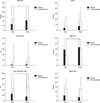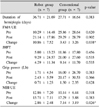Abstract
Objective
To investigate the effects of short-term robot-assisted upper limb training on hemiplegic patients compared to conventional physical therapy.
Method
This study was a prospective, single-blinded, randomized controlled trial. Eighteen hemiplegic patients due to brain lesions were randomly assigned to: (1) robot-assisted upper limb training and conventional upper limb physical therapy for 30 min a day, respectively (Robot group); or (2) conventional upper limb physical therapy for 30 min twice a day (Conventional group). All interventions were provided for 2 weeks, 5 times a week. Each patient was evaluated at pre- and post-treatment by the Fugl-Meyer assessment-upper extremity (FMA-UE), Jebsen hand function test (JHFT), grip power, modified Barthel index-upper extremity (MBI-UE), line bisection test, and Albert test.
Results
The Robot group showed significant improvement in FMA-UE (pre: 13.22 ± 14.20, post: 21.67 ± 15.84; p = 0.018), MBI-UE (pre: 14.33 ± 7.42, post: 16.56 ± 6.95; p = 0.041), and line bisection test (pre: 25.15 ± 34.48, post: 14.93 ± 28.38; p = 0.043). The Conventional group showed significant improvement only in MBI-UE (pre: 9.22 ± 6.06, post: 15.56 ± 6.19; p = 0.008). The improvement in MBI-UE was larger in the Conventional group than Robot group (6.33 ± 3.28 vs. 2.22 ± 2.49; p = 0.014).
Conclusion
This study suggests that short-term robot-assisted upper limb training may improve upper limb function in hemiplegic patients. However, proper physical therapy may be needed to transfer improved upper limb function to activity of daily living. In addition, goal-directed reaching tasks using a robot are expected to be a treatment option for hemineglect.
Figures and Tables
 | Fig. 1InMotion 2.0 robot. Hemiplegic patients were engaged in goal-directed, planar reaching tasks that emphasized shoulder and elbow movements. |
 | Fig. 3Outcomes in the 2 intervention groups. FMA-UE: Fugl-Meyer assessment-upper extremity, JHFT: Jebsen hand function test, MBI-UE: modified Barthel index-upper extremity. Asterisk indicates the significant difference between two tests (p<0.05). |
 | Fig. 4FMA-UE and MBI-UE scores of individual patients. FMA-UE: Fugl-Meyer assessment-upper extremity, MBI-UE: modified Barthel index-upper extremity. |
References
1. Kwakkel G, Kollen BJ, van der Grond J, Prevo AJ. Probability of regaining dexterity in the flaccid upper limb: impact of severity of paresis and time since onset in acute stroke. Stroke. 2003; 34:2181–2186.
2. Hendricks HT, van Limbeek J, Geurts AC, Zwarts MJ. Motor recovery after stroke: a systematic review of the literature. Arch Phys Med Rehabil. 2002; 83:1629–1637.
3. Lai SM, Studenski S, Duncan PW, Perera S. Persisting consequences of stroke measured by the Stroke Impact Scale. Stroke. 2002; 33:1840–1844.
4. Nichols-Larsen DS, Clark PC, Zeringue A, Greenspan A, Blanton S. Factors influencing stroke survivors' quality of life during subacute recovery. Stroke. 2005; 36:1480–1484.
5. Volpe BT, Krebs HI, Hogan N. Is robot-aided sensorimotor training in stroke rehabilitation a realistic option? Curr Opin Neurol. 2001; 14:745–752.
6. Mehrholz J, Platz T, Kugler J, Pohl M. Electromechanical and robot-assisted arm training for improving arm function and activities of daily living after stroke. Cochrane Database Syst Rev. 2008; (4):CD006876.
7. Mehrholz J, Hädrich A, Platz T, Kugler J, Pohl M. Electromechanical and robot-assisted arm training for improving generic activities of daily living, arm function, and arm muscle strength after stroke. Cochrane Database Syst Rev. 2012; 6:CD006876.
8. Volpe BT, Krebs HI, Hogan N, Edelsteinn L, Diels CM, Aisen ML. Robot training enhanced motor outcome in patients with stroke maintained over 3 years. Neurology. 1999; 53:1874–1876.
9. Volpe BT, Krebs HI, Hogan N, Edelstein OL, Diels C, Aisen M. A novel approach to stroke rehabilitation: robot-aided sensorimotor stimulation. Neurology. 2000; 54:1938–1944.
10. Fasoli SE, Krebs HI, Stein J, Frontera WR, Hughes R, Hogan N. Robotic therapy for chronic motor impairments after stroke: Follow-up results. Arch Phys Med Rehabil. 2004; 85:1106–1111.
11. Fasoli SE, Krebs HI, Stein J, Frontera WR, Hogan N. Effects of robotic therapy on motor impairment and recovery in chronic stroke. Arch Phys Med Rehabil. 2003; 84:477–482.
12. Ferraro M, Palazzolo JJ, Krol J, Krebs HI, Hogan N, Volpe BT. Robot-aided sensorimotor arm training improves outcome in patients with chronic stroke. Neurology. 2003; 61:1604–1607.
13. Volpe BT, Lynch D, Rykman-Berland A, Ferraro M, Galgano M, Hogan N, Krebs HI. Intensive sensorimotor arm training mediated by therapist or robot improves hemiparesis in patients with chronic stroke. Neurorehabil Neural Repair. 2008; 22:305–310.
14. Lo AC, Guarino PD, Richards LG, Haselkorn JK, Wittenberg GF, Federman DG, Ringer RJ, Wagner TH, Krebs HI, Volpe BT, Bever CT Jr, Bravata DM, Duncan PW, Corn BH, Maffucci AD, Nadeau SE, Conroy SS, Powell JM, Huang GD, Peduzzi P. Robot-assisted therapy for long-term upper-limb impairment after stroke. N Engl J Med. 2010; 362:1772–1783.
15. Fugl-Meyer AR, Jaasko L, Leyman I, Olsson S, Steglind S. The post-stroke hemiplegic patient. 1. a method for evaluation of physical performance. Scand J Rehabil Med. 1975; 7:13–31.
16. Platz T, Pinkowski C, van Wijck F, Kim IH, di Bella P, Johnson G. Reliability and validity of arm function assessment with standardized guidelines for the Fugl-Meyer Test, Action Research Arm Test and Box and Block Test: a multicentre study. Clin Rehabil. 2005; 19:404–411.
17. Jebsen RH, Taylor N, Trieschmann RB, Trotter MJ, Howard LA. An objective and standardized test of hand function. Arch Phys Med Rehabil. 1969; 50:311–319.
18. Kim JH, Kim IS, Han TR. New scoring system for jebsen hand function test. J Korean Acad Rehabil Med. 2007; 31:623–629.
19. Shah S, Vanclay F, Cooper B. Improving the sensitivity of the Barthel Index for stroke rehabilitation. J Clin Epidemiol. 1989; 42:703–709.
20. Schenkenberg T, Bradford DC, Ajax ET. Line bisection and unilateral visual neglect in patients with neurologic impairment. Neurology. 1980; 30:509–517.
21. Albert ML. A simple test of visual neglect. Neurology. 1973; 23:658–664.
22. Nudo RJ, Milliken GW, Jenkins WM, Merzenich MM. Use-dependent alterations of movement representations in primary motor cortex of adult squirrel monkeys. J Neurosci. 1996; 16:785–807.
23. Teasell R, Bayona NA, Bitensky J. Plasticity and reorganization of the brain post stroke. Top Stroke Rehabil. 2005; 12:11–26.
24. Turkstra LS, Holland AL, Bays GA. The neuroscience of recovery and rehabilitation: what have we learned from animal research? Arch Phys Med Rehabil. 2003; 84:604–612.
25. Krebs HI, Hogan N. Robotic therapy: the tipping point. Am J Phys Med Rehabil. 2012; 91:S290–S297.
26. Hubbard IJ, Parsons MW, Neilson C, Carey LM. Task-specific training: evidence for and translation to clinical practice. Occup Ther Int. 2009; 16:175–189.
27. Krebs HI, Volpe BT, Williams D, Celestino J, Charles SK, Lynch D, Hogan N. Robot-aided neurorehabilitation: a robot for wrist rehabilitation. IEEE Trans Neural Syst Rehabil Eng. 2007; 15:327–335.
28. Staubli P, Nef T, Klamroth-Marganska V, Riener R. Effects of intensive arm training with the rehabilitation robot ARMin II in chronic stroke patients: four single-cases. J Neuroeng Rehabil. 2009; 6:46.
29. Sale P, Lombardi V, Franceschini M. Hand robotics rehabilitation: feasibility and preliminary results of a robotic treatment in patients with hemiparesis. Stroke Res Treat. 2012; 2012:820931.
30. Hwang CH, Seong JW, Son DS. Individual finger synchronized robot-assisted hand rehabilitation in subacute to chronic stroke: a prospective randomized clinical trial of efficacy. Clin Rehabil. 2012; 26:696–704.
31. Bowen A, McKenna K, Tallis RC. Reasons for variability in the reported rate of occurrence of unilateral spatial neglect after stroke. Stroke. 1999; 30:1196–1202.
32. Marshall RS. Rehabilitation approaches to hemineglect. Neurologist. 2009; 15:185–192.




 PDF
PDF ePub
ePub Citation
Citation Print
Print






 XML Download
XML Download